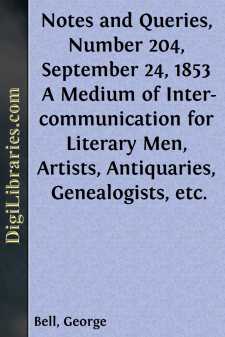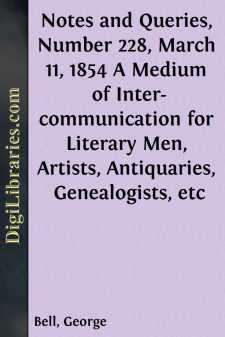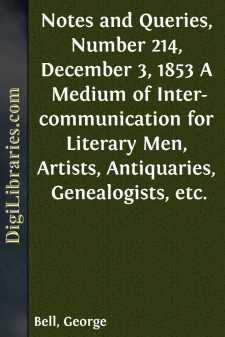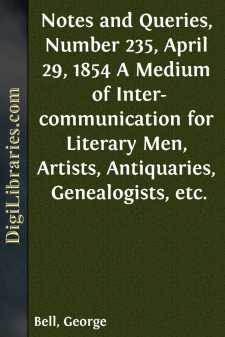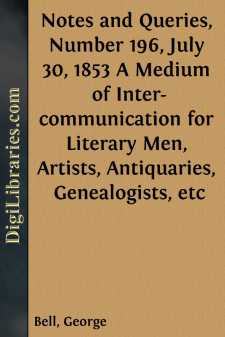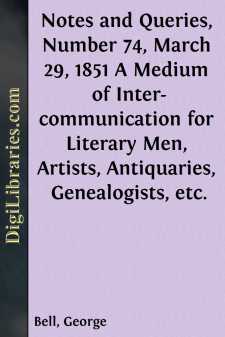Categories
- Antiques & Collectibles 13
- Architecture 36
- Art 48
- Bibles 22
- Biography & Autobiography 813
- Body, Mind & Spirit 142
- Business & Economics 28
- Children's Books 15
- Children's Fiction 12
- Computers 4
- Cooking 94
- Crafts & Hobbies 4
- Drama 346
- Education 46
- Family & Relationships 57
- Fiction 11828
- Games 19
- Gardening 17
- Health & Fitness 34
- History 1377
- House & Home 1
- Humor 147
- Juvenile Fiction 1873
- Juvenile Nonfiction 202
- Language Arts & Disciplines 88
- Law 16
- Literary Collections 686
- Literary Criticism 179
- Mathematics 13
- Medical 41
- Music 40
- Nature 179
- Non-Classifiable 1768
- Performing Arts 7
- Periodicals 1453
- Philosophy 64
- Photography 2
- Poetry 896
- Political Science 203
- Psychology 42
- Reference 154
- Religion 513
- Science 126
- Self-Help 84
- Social Science 81
- Sports & Recreation 34
- Study Aids 3
- Technology & Engineering 59
- Transportation 23
- Travel 463
- True Crime 29
Notes and Queries, Number 204, September 24, 1853 A Medium of Inter-communication for Literary Men, Artists, Antiquaries, Genealogists, etc.
by: George Bell
Categories:
Description:
Excerpt
EXTINCT VOLCANOS AND MOUNTAINS OF GOLD IN SCOTLAND.
It is by some supposed that the Hill of Noth, in the parish of Rhynie, Aberdeenshire, had at one time been a volcano in full operation: others, again, maintain that the scoria found on and in the neighbourhood are portions of a vitrified fort, which had at one time stood on its summit. I am not aware that the matter has been investigated since our advancement in the science of geology has enabled us to have a more intimate knowledge of these things than formerly. The last statistical account of Scotland has suffered severely in its Aberdeenshire volume, in consequence of the temporary deposition of the "seven Strathbogie clergymen." The accounts of their several parishes were written by parties only newly come to reside in them, and who appear to have taken little interest in it; and Rhynie is one of these. Those who argue for its having been a volcano, say that it is very possible that there may at one time have been an electric or magnetic chain connecting it with subterranean fire in some other quarter of the world; and that by some convulsion of nature, the spinal cord of its existence had been broken, and life became extinct. This hypothesis has been acted on, in accounting for the earthquakes which occur at Comrie in Perthshire. The great storm which devastated the princely estates of Earl Goodwin in Kent (circa anno 1098), and now so well known to mariners as the Goodwin Sands, is also said to have laid waste the parish of Forvie, in Aberdeenshire. On the occasion of the great earthquake at Lisbon in 1755, a flock of sheep were drowned in their cot in the neighbourhood of Lossiemouth, near Elgin, by the overflowing of the tide, although far removed from ordinary high-water-mark. Assuming this mountain to have been a volcano, are there any others in Great Britain? While on the subject of mountains in that quarter, there is another which also demands attention for quite a different reason, the Hill of Dun-o-Deer, in the parish of Insch: a conical hill of no great elevation, on the top of which stand the remains of a vitrified fort or castle, said to have been built by King Gregory about the year 880, and was used by that monarch as a hunting-seat and where, combining business with pleasure, he is said to have meted out even-handed justice to his subjects in the Garioch. It has long been the popular belief that this hill contains gold; and that the teeth of sheep fed on it assume a yellower tinge, and also that their fat is of the same colour. Notwithstanding this, no attempt at scientific investigation has ever been made. The operations on the line of the Great North of Scotland Railway, now in progress in the immediate neighbourhood, may possibly bring something to light. This line passes for many miles through a country particularly rich in recollections of the "olden time"—cairns, camps, old chapels, druidical circles, sculptured stones, &c. and where ancient coins, battle-axes of all the three periods, urns and elf-arrow heads, Roman armour, &c., have been disinterred by the ordinary labours of the field....


